Natural Recovery Strategies for Runners (Perfect For New York Marathon Runners)

With the New York Marathon on the horizon, the intensity of marathon training has reached its peak, and runners are flocking to clinics seeking relief from the wear and tear of their rigorous regimens.
As a dedicated runner, we know that you understand the importance of training hard, but it’s also important to recognize the significance of recovery strategies.
In this blog, you can discover natural recovery methods that can benefit both marathon runners and shorter-distance runners who prefer a 5K over the grueling marathon distance
You can also discover the often-misunderstood practice of foam rolling, and learn the potential pitfalls and how to avoid them so it doesn’t mess up your training.
The Importance of Recovery for Runners
Before we dive into the specifics of recovery strategies, it’s crucial to emphasize why recovery is so essential, especially for those preparing for long-distance races like the New York Marathon.
Running places significant stress on the muscles, joints, and connective tissues, and without proper recovery, these areas can become prone to injuries and chronic pain.
Failure to recover means you either suffer with pain as you run, can’t perform at your best, or simply can’t run at all!
Natural Strategies To Recover From Running Injuries
A lot of people visit our clinic seeking natural strategies that don’t include taking pills, having injections, or more drastic steps like surgery for long-term problems (knees are a common problem area for runners).
1. Rest and Active Recovery
Marathon training can be grueling, and the temptation to push through fatigue is ever-present.
However, incorporating rest days and active recovery sessions into your training plan is vital.
Rest allows your body to heal and adapt to the stress of running, reducing the risk of overuse injuries.
But you don’t have to sit on the sofa and do nothing – Active recovery activities like cycling, swimming, or gentle yoga can promote blood flow to sore muscles, aid in their recovery, and help you stay active without being too taxing on your body.
2. Proper Nutrition and Hydration
Nutrition plays a significant role in recovery.
Ensure you’re getting an adequate intake of carbohydrates, proteins, and healthy fats to support muscle repair and replenish glycogen stores.
And don’t forget to stay well-hydrated which is equally important to prevent cramping and maintain overall bodily function.
3. Stretching and Mobility Exercises
Incorporating stretching and mobility exercises into your routine can help improve your flexibility and reduce muscle tightness.
Focus on areas that are commonly affected by running, such as the calves, hamstrings, and hip flexors.
Yoga and Pilates can be excellent choices for enhancing flexibility and balance, but if you are still experiencing stiffness and tightness, you will benefit from getting hands-on therapy from an expert physical therapist in our New York City clinic.
The Do’s and Don’ts of Foam Rolling For Runners
Foam rolling has gained popularity as a recovery tool among runners, but it’s essential to use it correctly to avoid potential harm:
1. Choose the Right Foam Rolling Technique
Not all foam rolling techniques are suitable for everyone and this is a common mistake (assuming what’s worked for someone else will work for you).
If you’re unsure about which areas to target or which techniques to use, arrange a Free “No Sweat” Discovery Visit and we can help you understand why you’re in pain, and the most effective ways to treat it.
If you use the wrong technique or the wrong type of foam roller, you can actually make things worse!
2. Avoid Overdoing It
Foam rolling should be used in moderation.
Excessive foam rolling, especially on the IT (iliotibial) band, can lead to overuse injuries and irritation.
So limit your foam rolling sessions to 10-15 minutes and start by using gentle to moderate pressure.
3. Identify the Root Cause
While foam rolling can provide temporary relief, it’s essential to identify the underlying causes of your running injuries.
Is it a problem with your running form, muscle imbalances, or worn-out shoes?
Addressing these issues will be more effective in the long run than solely relying on foam rolling.
Quick Tip: Listen to Your Body
Finally, a quick tip for marathon runners dealing with pain during training…
When you feel pain creeping in, don’t hesitate to take a few minutes to walk and reassess.
Sometimes, psychological stress can amplify physical discomfort.
By briefly slowing down and regaining your composure, you can make it much easier to push through the challenging moments of a race.
The Fastest Way To End Running Injuries In Time For The New York Marathon
If you’re an avid runner, you’ve probably tried a lot of recovery strategies you found online, or through social media.
Maybe you’ve ever had a massage or bought yourself a massage gun.
But if your pain is still a problem, clearly the cause is something that you aren’t able to fix yourself – or it would be fixed by now, right?
So here’s what we invite you to do…
Book Your Free Running Injury Consultation
This free appointment with an expert physical therapist is your chance to share your story, get the personalized advice you desperately need, and learn about the natural treatment options that have helped thousands of New Yorker’s in our clinic.
Click HERE to arrange your Free Running Injury Consultation now!
As we mentioned, our clinic is very busy now – with a lot of runners too – so we only have 6 of these available right now.
So call us urgently on 646-430-5717 now to get yours, and take the fastest route to pain-free running!
